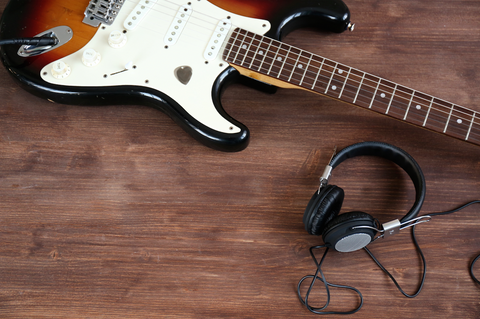-
Audio
-
Guitar
-
Bass
-
Blog
-
SALE
- Financing
- Support
- SINCE 1946
September 28, 2016
The human ear naturally perceives midrange frequencies more prominently, and the guitar tends to sit naturally in that range. However, many factors in a live mix can make the guitar hard to hear for both the guitarists themselves and the audience, and it’s not always the guitarist’s fault. If your guitar is getting buried by your band, there are a few things you can try.
September 23, 2016
Swapping out a set of power amp tubes for another can change up your tone in a subtle but significant way. This article will highlight the basic tonal characteristics of common power tubes and help you find the right one for you. Please note that swapping out tubes is a process that is best left to an experienced amplifier technician- the amount of voltage present in tubes amplifiers can be lethal if they are not discharged correctly.
September 21, 2016
The entertainment business has always been a “no-excuse” industry. Ever since the phrase “the show must go on!” was first coined in the 1800s by the circus industry, it has been repeated by stage managers everywhere. Whether you make your living playing music or you are a weekend warrior for fun, a good trouble shooting approach will let you go on with the show. Second chances are hard to get, so you need to make that first shot work. Make sure you’ve prepared not only your music but also make sure your equipment is reliable and well-maintained. Unfortunately there is no way to predict when a bad connection or worse a failure will develop in your guitar system, but it is likely at some point you will turn up your guitar on stage and find there is no sound coming out. The good news is that by following a few simple steps, any musician can learn to quickly find which part of the system isn’t working and bypass it to keep the music going.
September 20, 2016
Reverb is a classic guitar effect that can breathe some new life into your guitar sound and add some nice dimension and depth. From shimmering surf guitar to shoegaze swells, reverb is undoubtedly a rock and roll mainstay. Used and loved by producers since the ’50s and ’60s, reverb was originally created in numerous ways. Bands could record in a highly reverberant echo chamber, a room acoustically tuned to provide natural reverberation. Spring reverb and plate reverb were also used, and they are basically what they sound like. Spring reverb utilizes the vibration of a metal spring to create reverb and plate reverb bounces the sound off of a metal plate. As time went on, digital reverb technology found its way into rackmount units and effects pedals. This allowed guitarists to take reverb on the go conveniently and custom tailor it to their liking onstage or in the studio.
September 15, 2016

Since their invention way back in the early 1900s, vacuum tubes have seen use in a wide variety of industries and applications, from old CRT televisions to computers to microwave ovens. When amplification was introduced to the music industry, tubes quickly became the cornerstone of countless genres. The sweet, singing sustain of a tube amp is synonymous with rock and roll, country, and blues, to name a few. Let’s take a basic look at these little devices that give our guitars such a big sound!
September 15, 2016
If you were to buy a new guitar amplifier tomorrow, what would be your primary consideration? For many musicians, it would be what gives them the tone they want. It may also be based on what their musical heroes use. And it's completely understandable- we all want gear that speaks to us, our audience and helps to shape our signature sound.
September 14, 2016

Whether you’re jamming with a garage band or playing stadiums, it’s essential to protect your hearing. Our hearing is one of our most valuable tools we have as musicians, and once it’s gone it’s gone for good. In fact, if you leave a gig with your ears ringing, permanent damage has already been done to your hearing. Furthermore, if you constantly expose yourself to excessively loud volumes over a long period of time, you may develop Tinnitus, which is a constant ringing in your ears. In severe cases, that ringing may turn into buzzing, humming, or even singing sounds. Any kind of additional voices in your head is definitely something you want to avoid.
September 09, 2016

Whether you’re at the studio using your amp head as a preamp or jamming with headphones at home, it’s very important to know which circumstances require that you connect speakers to your amp. This article will break it down for you!
September 08, 2016

In response to our recent series about replacing tubes in your amplifier, we received the following question from a Carvin Audio enthusiast:
“Great article. I would like to see an article that describes how the power tubes are correctly biased. Ex: I own a Carvin Audio V3M head, but it uses Electro-Harmonix power tubes. If I want to use Sovtek EL84s what must the voltage for the output tubes be set at? Lastly, I hope Carvin Audio can develop a power amp with a self biasing output section like my Mesa Tremoverb had. All I had to do was select EL-34, 5881, or 6L6…It self adjusted to whatever power tubes I decided to use.”
August 29, 2016
One way you can affordably tailor your tube amplifier’s sound is by trying out different preamp tubes. This is possible because unlike power tubes which require expert bias adjustment, preamp tubes are self-biasing in the circuit. Because of this you can learn to swap out your amplifier’s preamp tubes in only minutes without specialized tools. What difference can changing your preamp tubes really make? Well, you can customize how much gain the stage has available, select a particular tube for the way it colors your equalization, the location of a high or low gain tube in the amp’s signal can change your distortion and tone character, and you can even choose a tube for more subtle features like ultra-low noise, durability or extra headroom. As it happens, quite a wide range of variations can be accomplished by replacing a part that usually costs less than $20.
August 26, 2016

Getting into the world of effects pedals can be an intimidating task (and not to mention expensive, too)! There are hundreds of pedal manufacturers and thousands of effects to choose from to help define your sonic identity. If you're just getting started with effects, this quick guide will outline the basic ways to implement some stomp boxes into your arsenal.
August 25, 2016

A live performance situation where gear is backlined or shared among performing bands is quite common. Inevitably you will run into a situation where you need to share an amplifier with another band on the bill, most likely the headliner, or the venue provides a rented setup for you to use. This may be arranged in order to reduce tear down time between bands, simplify the load in process, or accommodate a touring band.
Sign up to get the latest on sales, new releases and more…
NoFraud Frequently Asked Questions
"Make a joyful noise unto the Lord all of the earth; make a loud noise and rejoice and sing praises. Sing to the Lord with the harp and the voice of the psalm." - Psalm 98:4-5
© 2025 Carvin Audio.
Carvin Corp.
POS and Ecommerce by Shopify
